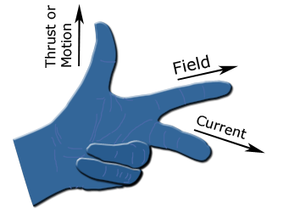CONTENT
- Force on a Current Carrying Conductor in a Magnetic Field
- Fleming Left Hand Rule
- Application – D.C Motors, Moving coil galvanometer
- Force on a Moving Charge in a Magnetic Field
FORCE ON A CURRENT CARRYING CONDUCTOR IN A MAGNETIC FIELD
A conductor carrying an electric current, when placed in the magnetic field experiences a mechanical force. This can be demonstrated by using a set up a shown below. Two metal rails fixed on each side of a powerful horse-shoe magnet. A copper rod is placed across the rays. When the current is passed through this copper rod, it is observed that the copper rod rolls along the rays, toward the right. If by adjusting the rheostat, more current is made to flow through the rod. One will notice that the rod moves faster, thus the force on the rod increases when the current increases.
If the direction of flow of current is reversed by reversing the connections at the battery terminals, the rod will be observed to move towards the left, opposite to the previous direction of motion.
If one turns the magnet such that the magnetic field is parallel to the length of the rod as shown below, it will be observed that the current carrying rod remains stationary no matter the amount of current that passes through. There is therefore no force on the rod.
The direction of the force on a current carrying conductor placed perpendicular to the magnetic field is given by Fleming’s left-hand rule which is stated as follows:
If the thumb, forefinger and middle finger are held mutually at right angles to one another with the fore-finger pointing in the direction of magnetic field, and the second finger in the direction of Current, then the thumb will point in the direction of Motion (or force producing the motion).

EVALUATION
Explain the effects of force on a current carrying conductor in a magnetic field?
APPLICATIONS OF ELECTROMAGNETIC FIELD
- ELECTRIC MOTOR
The electric motor is a device for converting electrical energy into mechanical energy. It consists of the following
(i) a rectangular coil of insulated wire, known as armature,
(ii)a powerful magnetic field in which the armature turns is provided by two curve pole pieces of a powerful magnet.
(iii) acommutator consisting of a split copper ring, two halves of which are insulated from each other.
(iv) two carbon brushes which are made to press lightly against either side of the split-ring commutator
- MOVING COIL GALVANOMETER
This galvanometer is one of the most sensitive and accurate methods for detecting or measuring extremely small currents or potential differences.
Structure:
It consists essentially of:
- a light rectangular vertical coil ABCD pivoted in jeweled bearings such that it can move in a vertical plane
- two curved pole piece of a horse shoe magnet and a soft iron core or cylinder inserted between the pole pieces.
- two spiral non-magnetic control springs of phosphor bronze, each of which is attached to the jeweled bearing or spindle. Current enters or leaves the rectangular coil through these spiral springs. The springs also provide the control couple.
STUDENT PROJECT
Draw the structures of the electric motor and the moving coil galvanometer. Explain the working principle of both.
FORCE ON A MOVING CHARGE IN A MAGNETIC FIELD
The force on a charge q moving with a velocity v ( less than the velocity of light) in a magnetic field of strength B is given by:
F = qvB
READING ASSIGNMENT
New School Physics for Senior Secondary Schools (M.WAnyakoha Pages 425 -428)
GENERAL EVALAUTION
- A body of mass 4.0Kg moving with a speed of 2.5m/s collides with a stationary body of mass 0.2Kg. if the bodies stick together after collision, calculate the magnitude of the velocity with which they move.
- A body of mass 4.0Kg is accelerated from rest by a steady force of 9N. What is its speed when it has travelled a distance of 8m?
WEEKEND ASSIGNMENT
- In a D.C motor, the split-ring commutator ensures that (a) the direction of the current in the coil is reversed after every half turn (b) the flow of current in the coil is constant (c) the wires carrying the current to the coil do not get tangled (d) the magnitude of the current is progressively increased.
- The force on a charge moving in a magnetic field is ……….. to the speed of the charge (a). inversely proportional (b) opposite (c) directly proportional to the (d) parallel
- What is the force on an electron of charge -1.6 X 10-19C, mass 9.1 X 10-31Kg and speed2.0 X 107ms-1which enters perpendicularly into a magnetic field of strength 0.010T (a) 3.2 X 10 -14N(b) 3.2 X 10 -12N (c) 5.2 X 10 -24N (d) 3.5 X 10 -12N
- Calculate the radius of the circular path travelled by the electron in (4) above. (a) 3.2 X 10 -14m (b) 1.2 X 10 -4m (c) 1.14 X 10 -2m (d) 4.12 X 10 -14m
- When the direction of current in a conductor is parallel to the magnetic field, the force of the conductor is …… (a) maximum (b) perpendicular (c) zero (d) opposite the field.
THEORY
- State Fleming’s left hand rule.
- Explain how the direction of current in a conductor placed in a magnetic field affects the force on the conductor.
Read our disclaimer.
AD: Take Free online baptism course: Preachi.com 